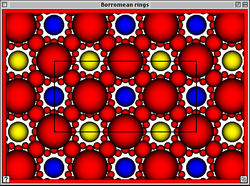SnapPea

SnapPea is free software designed to help mathematicians, in particular low-dimensional topologists, study hyperbolic 3-manifolds. The primary developer is Jeffrey Weeks, who created the first version as part of his doctoral thesis, supervised by William Thurston. The latest version is 3.0d3. Marc Culler, Nathan Dunfield and collaborators have extended the SnapPea kernel and written Python extension modules which allow the kernel to be used in a Python program or in the interpreter. They also provide a graphical user interface written in Python which runs under most operating systems (see external links below).
The following people are credited in SnapPea 2.5.3's list of acknowledgments: Colin Adams, Bill Arveson, Pat Callahan, Joe Christy, Dave Gabai, Charlie Gunn, Martin Hildebrand, Craig Hodgson, Diane Hoffoss, A. C. Manoharan, Al Marden, Dick McGehee, Rob Meyerhoff, Lee Mosher, Walter Neumann, Carlo Petronio, Mark Phillips, Alan Reid, and Makoto Sakuma.
The C source code is extensively commented by Weeks and contains useful descriptions of the mathematics involved with references.
The SnapPeaKernel is released under GNU GPL 2+[1] as is SnapPy.[2]
Algorithms and functions
At the core of SnapPea are two main algorithms. The first attempts to find a minimal ideal triangulation of a given link complement. The second computes the canonical decomposition of a cusped hyperbolic 3-manifold. Almost all the other functions of SnapPea rely in some way on one of these decompositions.
Minimal ideal triangulation
SnapPea inputs data in a variety of formats. Given a link diagram, SnapPea can ideally triangulate the link complement. It then performs a sequence of simplifications to find a minimal ideal triangulation.
Once a minimal ideal triangulation is found, SnapPea can try and find a hyperbolic structure. In his Princeton lecture notes, Thurston noted a method for describing the geometric shape of each hyperbolic tetrahedron by a complex number and a set of nonlinear equations of complex variables whose solution would give a complete hyperbolic metric on the 3-manifold. These equations consist of edge equations and cusp (completeness) equations. SnapPea uses an iterative method utilizing Newton's method to search for solutions. If no solution exists, then the link complement is retriangulated randomly, repeating the process.
The minimality of the triangulation is meant to increase the likelihood that such a solution exists, since heuristically one might expect the minimal triangulation to be "straightened" without causing degenerations or overlapping of tetrahedra.
From this description of the hyperbolic structure on a link complement, SnapPea can then perform hyperbolic Dehn filling on the cusps to obtain more hyperbolic 3-manifolds. SnapPea does this by taking any given slopes which determine certain Dehn filling equations (also explained in Thurston's notes), and then adjusting the shapes of the ideal tetrahedra to give solutions to these equations and the edge equations. This gives an (incomplete) hyperbolic structure on almost all of the Dehn-filled manifold. The completion gives a hyperbolic structure on the entire manifold. Its volume is the sum of the volumes of the adjusted tetrahedra.
Canonical decomposition
SnapPea is usually able to compute the canonical decomposition of a cusped hyperbolic 3-manifold from a given ideal triangulation. If not, then it randomly retriangulates and tries again. This has never been known to fail.
The canonical decomposition allows SnapPea to tell two cusped hyperbolic 3-manifolds apart by turning the problem of recognition into a combinatorial question, i.e. checking if the two manifolds have combinatorially equivalent canonical decompositions. SnapPea is also able to check if two closed hyperbolic 3-manifolds are isometric by drilling out short geodesics to create cusped hyperbolic 3-manifolds and then using the canonical decomposition as before.
The recognition algorithm allow SnapPea to tell two hyperbolic knots or links apart. Weeks, et al., were also able to compile different censuses of hyperbolic 3-manifolds by using the algorithm to cull lists of duplicates.
Additionally, from the canonical decomposition, SnapPea is able to:
- Compute the Ford domain
- Compute the symmetry group
Censuses
SnapPea has several databases of hyperbolic 3-manifolds available for systematic study.
- Cusped census
- Closed census
See also
- Regina incorporates aspects of SnapPea.
- Damian Heard's Orb allows hyperbolic manifolds with totally geodesic boundary, and also orbifolds where the orbifold locus contains trivalent vertices.
- Computational topology
References
- ↑ ReadMe file for the SnapPea kernel, accessed 2013-09-06.
- ↑ "SnapPy — SnapPy 2.1 documentation". Math.uic.edu. Retrieved 2014-03-12.
- Weeks, Jeffrey R., SnapPea C source code, (1999)
- Weeks, Jeffrey R., Convex hulls and isometries of cusped hyperbolic $3$-manifolds. Topology Appl. 52 (1993), no. 2, 127—149.